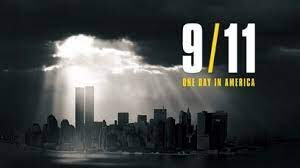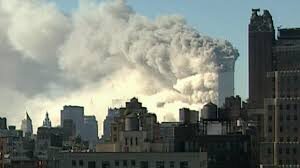Issue of the Week: War



9/11: One Day in America, National Geographic TV, 8/31/21 through 9/11/21
Tomorrow is the 20th anniversary of 9/11. No one needs to say or write more than 9/11 to explain or know what it was. It changed the world.
We highlight, out of many programs worth seeing, National Geographic’s six-part series, 9/11: One Day in America, linked here for streaming, airing starting on August 31st through today and tomorrow, and on-demand through National Geographic TV and Hulu.
This is the one documentary officially linked to the 9/11 Memorial and which most comprehensively immerses you in the experience that day through the eyes of the survivors.
Here’s an introduction in an article in National Geographic, Five things to know about new documentary series 9/11: One Day in America, by Simon Ingram, September 1, 2021:
Marking the 20th anniversary since the terrorist attacks of September 11, 2001, a harrowing new series from National Geographic aims to tell the definitive story of the day the world watched in horror.
TWENTY YEARS AGO this September 11th, as word spread of an incident in New York, people around the world gathered around the nearest TV screen and, for the first time, watched footage that would become infamous. Small huddles of people on the street, in bars, schools and building sites shared disbelief as first one, then another aircraft hit each of the twin towers of New York’s World Trade Centre. And as one, then the other tower collapsed, it became clear what they were witnessing was an event of historical magnitude. Whispers of another attack on the Pentagon, and of a plane crash somewhere elseadded to the confusion of a day that would change the world.
The scenes would be replayed endlessly in the coming years: the sickening plunge of the planes into the towers, clouds of ash, injured people dressed for the office being hauled arm-in-arm by emergency personnel, and towers of smoke and dust where two of the world’s tallest buildings stood only hours earlier. All would make September 11th 2001 the most visually notorious terror attack in history, as well as the most devastating to human life – with nearly three thousand lives lost in the buildings, aboard the planes and on the streets.
But to those on the ground, that day began like any other. And on that day, as the catastrophe unfolded, nobody knew how it would end.
Like the assassination of President Kennedy nearly four decades earlier in 1963, those who witnessed it never forget exactly where they were. Daniel Bogado, director of the new National Geographic documentary series 9/11: One Day in America – produced in association with the 9/11 Memorial and Museum – remembers it well. Recently arrived in London from Paraguay, the 20 year-old received a call from a friend. “He said, turn on your TV, it’s the end of the world,” he told National Geographic UK.

Here are five things about 9/11: One Day in America that make its depiction of the attack and its aftermath as compelling, and vital, as it’s ever been.
The camera doesn’t blink
With twenty years having passed and countless documentaries already made about 9/11, how is it possible to offer a new perspective on the tragedy that unfolded under the glare of the world?
One thing strikingly absent from 9/11: One Day in America is reconstruction, over-arching narration or visualisation: the series is entirely archive led, tied together by new interviews with survivors, and relatives of the victims of the atrocities of the day. As Bogado recalls, this approach allowed not only the horror to sink in, but also the humanity. “I’d just come from [another] series, and the best times in the edit were when we were working with archive. The audience know, this is real, this is happening, you’re watching reality. But there were elements that were non-archive. We had to film visualisations, and they were always tricky. We’d spend months editing, and it was never satisfactory.”
When approached to direct 9/11: One Day in America – pitched by executive producer David Glover as ‘finding the most extraordinary stories of September the 11th and telling them as this grand narrative, all led by archive’ – Bogado hit the desk first. “I watched as many documentaries as I could to see what was already out there. I didn’t see the point of just doing something that had already been done. But I didn’t see anything that was like what we were doing. What we were doing was a series, which gave it a much wider canvas. What it allowed us to do was to play the archive long. We didn’t want to do illustration – we wanted to do immersive.”
“”These people were going to their ordinary life, to their work, and it turned into a warzone between one second and the next. And that is profoundly traumatising.””
It takes a real-time approach to chronology
“September 11 was an interesting day because technology wasn’t at the same point where people have a video camera on their phone,” says Bogado. “If something like that happened today – say the Capitol Hill riot – there would be just so many cameras, hours and hours [of footage]. “At the same time, it was New York City, which is probably the media capital of the world. There was a mayoral election in the morning, so there were a lot of news crews with proper cameras hanging around, and a documentary crew following [Ladder 1 firehouse]… . So you had all this footage coming in from all these different sources.”
Certain parts of that footage is now infamous – but instead of offering every angle on key moments, the series takes a more immersive, real-time approach to its edit. “The terrorists knew that if they burned those buildings in that horrific way, it would be shown all around the world, that’s what they were looking for.” Bogado says. In that sense, the repetition of the moments the planes hit from every angle, or the moments each tower collapsed, perpetuated the terror of the day – but perhaps also betray the suddenness with which the events transpired under the eyes of New York. Which meant the filmmakers had choices to make to keep the documentary’s near real-time narrative cohesive.
“When you see the plane hit, you only see it once,” says Bogado. “The second you change the angle, you’re stepping back in time – and that doesn’t happen in real life. So you lose the sense of immersiveness. That was the approach we took. It really was the amazing work of the editors, an incredibly talented team, to bring all those elements together and make it work seamlessly.”


It’s for those who said ‘never forget.’ But also those who weren’t there to remember.
With twenty years having passed, to a whole generation the scenes depicted in 9/11: One Day in America weren’t a memory. Therefore, beyond their ambition to make a landmark series, Bogado and his team had to tell the story in a way that would educate as well as remind. “We said ‘never forget’, but there’s a whole generation that wasn’t alive,” he says. “We found a lot of young people really don’t know a lot about September 11th. So there was an opportunity here to craft a series that was very compelling, and had these moral messages about the way people behaved. That really informs people about the scale of the horror, but also the scale of the humanity.”
The series was made in collaboration with the 9/11 Memorial and Museum, which combined with the anniversary and the scope of the series, placed a certain responsibility on the filmmakers. “It was also a privilege to be trusted with this job. But at the same time you can’t let the pressure overwhelm you,” says Bogado. “Once you’ve made that promise to a [interview] contributor that you’re going to work very very hard to make this series extraordinary, you’ve committed yourself. You’ve got an obligation to them [because] they did their part, they came, they sat down, and relayed for us the worst day of their lives. Everybody on the table wanted to deliver for the contributors and the next generation.”
Survivors don’t just ‘get over it.’
Who were those contributors? Amongst the archive of video, phone-calls and snatches of radio traffic, the principal narrative thread of the series is provided by new interviews with those who were there on the day – and have now had two decades to reflect on the experience. And what is immediately clear is that people’s responses to living through the experience vary a lot.
“We had contributors who told us ‘I’ve never had a sleepless night, I’m not the type of person who suffers PTSD’, to people who told us they rarely leave their house [twenty years on] – and all things in between,” says Bogado. “One of the interesting things that I started asking people at the end of their interview, was ‘do people tell you to ‘get over it?’’ and almost everyone has, at some stage, told them to get over it.”


He adds: “I thought, well, anybody who says that, I don’t think they really grasp the scale of the horror of the day – what it must have been like to experience that, how absolutely destabilising that is to the core of your soul and your person.
“I have been to war zones – you prepare for weeks or months, and it’s a decision you made to go there. These people were going to their ordinary life, to their work, and it turned into a war zone between one second and the next. And that is profoundly traumatising.”
Amongst the horror, it looks for hope.
Chief amongst the motivations for telling the stories of the survivors was to bring to light the acts of heroism, humanity and sacrifice that emerged from the terror of the attacks. “We had debates about how much of the horror can you show?” says Daniel Bogado. “For me it was important that we don’t sanitise it, that we do show the reality – that we have a responsibilityto show the reality – but to couple that with stories of humanity and heroism.”
Bogado describes the message of hope as being a common thread in his documentary films, which often focus on a group of people who are oppressed, or some kind of injustice – and that in such circumstances, there will always ‘be people who are helping – people who are making a difference against extraordinary odds.’

Of September 11th he says, “if you just look at those images, all you see is terror, all you see is fear, civilians running for their lives. But then if you do the work we tried to do in this documentary, and you see the person being put in the ambulance – who are these people, who did they help, what happened to them later… it adds another layer which you might have been unaware of.”
Bogado adds: “Your first obligation as a filmmaker is to the truth, whatever that may be. And I think it’s quite inspiring that at the time like that, people really came together. And the stories really prove that.”
9/11: One Day in America premieres on the National Geographic Channel on August 31 at 9pm.